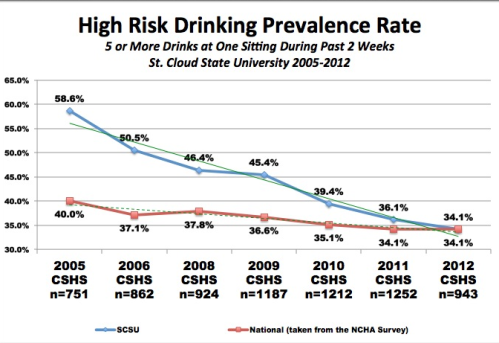By Jennifer Sell Matzke
Thanks to a series of successful collaborative efforts to alter the culture when it comes to alcohol and drug use on the campus of St. Cloud State University and the surrounding community, dramatic, positive and measurable changes are occurring.
In 2005, results from a college student health assessment showed that 58% of St. Cloud State students reported engaging in high risk drinking (defined as 5 or more alcohol beverages in a single sitting) within the last two weeks — a rate significantly above the national average reported by college students across the country. The negative consequences associated with this behavior were taking a toll not only on students but also on the campus and surrounding community.
In order to address this problem, SCSU implemented an environmental management approach to addressing high risk drinking and the related harmful consequences. Now, just seven years later, the high risk drinking rate for SCSU has fallen to 34.1%, a rate on par with the national average. This is a feat that is now bringing national attention to SCSU and the city of St. Cloud, primarily because of the partnerships that have evolved and developed to make this change possible.
This change in culture can be attributed in large part to the numerous collaborative efforts put forth between members of St. Cloud State University, the Neighborhood University Community Coalition, the St. Cloud Police Department and St. Cloud city administrators. In July 2010 the Social Host, Provisional Licensing for Liquor Establishments, and Disruptive Intoxication Ordinances were proposed as a collaborative effort by the various groups mentioned above to address concerns within the community. These ordinances were ultimately adopted in the city of St. Cloud and the impact has been extremely positive. For example, as a result of the Social Host Ordinance, the city has seen a drastic reduction in the number of loud parties and university neighbors report a significantly improved quality of life as a result.
In August of 2010, shortly after the new ordinances were passed, the city and university partnered together to introduce and implement the IMPACT Diversion Program. This joint program is designed to offer individuals who have been charged with an underage alcohol violation the opportunity to receive alcohol education and prevention services. The Diversion program has resulted in a reduction in underage consumption recidivism from 12% to 6.9%, in nearly 1900 cases in the past two years as well as a significant decrease in the number of alcohol related emergency room admissions. Since Diversion is also an option for non-students, underage individuals have returned to St. Cloud to complete Diversion from as far away as Illinois, North Dakota, Wisconsin, and Texas.
Beginning in fall 2012, SCSU has also partnered with St. Cloud Technical and Community College to provide IMPACT programming on their campus. The two colleges now share a graduate assistant who works to provide prevention programming to both campuses. These combined efforts have drastically changed the environment in the city of St. Cloud and the culture around drinking on campus at both SCSU and SCTCC.
Through these efforts, the city of St. Cloud and area colleges have witnessed firsthand the impact of collaboration in affecting change, the importance of partnerships and data collection and the power of education to reduce alcohol use. These efforts have been the catalyst for various other partnerships to address alcohol issues in the community. For example, the St. Cloud Community Alliance (SCCA) evolved out of these efforts and brings together city leaders, campus leaders, residents, students and businesses from throughout the city of St. Cloud and the surrounding communities. The SCCA is a coalition with a simple mission: to make St. Cloud a better place for everyone; with a primary focus to reduce high-risk drinking and the negative impacts on our community.
The collaborative relationships that were built and exist between these entities continue to thrive and provide numerous opportunities for partners to work together for the sake of creating an improved quality of life for all residents, students, visitors, faculty and staff within the city of St. Cloud.
Jennifer Sell Matzke is Interim Assistant Dean of Students for Chemical Health and Outreach Programming at St. Cloud State University.





